Physical Address
304 North Cardinal St.
Dorchester Center, MA 02124
Conventional radiography is and should be the initial imaging examination performed for a patient presenting with shoulder pain. Although radiographs provide limited evaluation of the rotator cuff and glenoid labrum, they can offer important information about the source of the patient's symptoms. Radiographs depict an assortment of osseous abnormalities, including fracture, arthritis, soft tissue calcifications, postsurgical changes, and tumor, and they are frequently complementary to more advanced imaging modalities, such as computed tomography (CT) and magnetic resonance imaging (MRI). A wide variety of radiographic views are available to aid in the evaluation of the glenohumeral joint. Knowledge about the advantages and disadvantages of each view will assist in optimizing imaging protocols, depending on the clinical presentation ( Box 38.1 ).
Anteroposterior (AP) view (external and internal rotation views)
Grashey view (true or neutral AP view of the glenohumeral joint)
Axillary view
Scapular Y view
Stryker notch view
Zanca view
The anteroposterior (AP) view ( Fig. 38.1A ) is obtained with the patient in either the upright or the supine position. The beam is directed in a true AP direction relative to the body. The glenoid rim is normally tilted anteriorly about 40 degrees, which results in overlap of the humeral head and glenoid rim in the AP view. This view can be obtained with the humeral head in the neutral position, internal rotation, or external rotation. When compared with other radiographic views of the shoulder, the AP view provides the best overview of the osseous structures of the shoulder girdle because the projection allows for relatively uniform distribution of soft tissue density across the entire shoulder. As a result, one or more of the AP views is nearly always included in the standard radiographic evaluation of the shoulder. These projections allow for adequate evaluation of the humeral head, glenoid, and body of the scapula, as well as the acromioclavicular (AC) joint and coracoid process. The AP projection is very helpful in the evaluation after acute trauma for evidence of fracture or dislocation and is also of value in assessing the cause of chronic pain from arthritis, impingement, calcific tendinitis/bursitis, tumor, or infection.
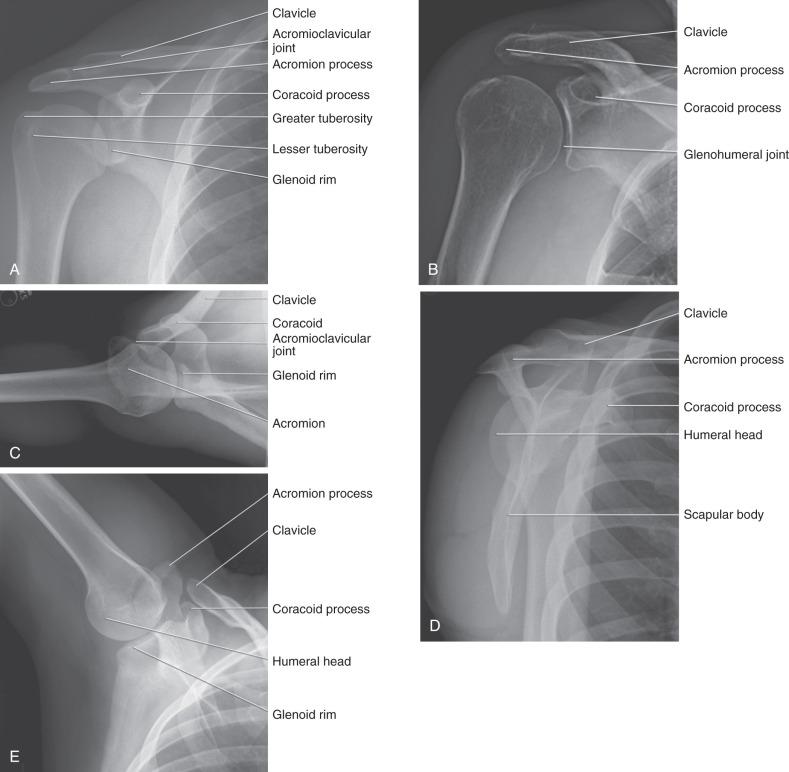
The Grashey view is a true or neutral AP view (see Fig. 38.1B ), and differs from the standard AP view in that the patient is rotated posteriorly 35 to 40 degrees, thus providing a tangential view of the glenohumeral joint. The advantage of the Grashey view is that it provides a superior evaluation of the glenohumeral joint. This view can demonstrate subtle subluxation in the superior or inferior direction and will show subtle joint space narrowing associated with glenohumeral arthritis. The disadvantage of this view is that a rapid change in soft tissue density occurs from medial to lateral, and as a result, the lateral aspect of the shoulder, including the acromion and AC joint, is difficult to evaluate because of a rapid change in density on the radiograph and loss of anatomic detail laterally. This loss can be decreased with use of a boomerang-shaped filter draped along the lateral shoulder.
Variations of the axillary lateral view exist, but the projection is most commonly obtained with the patient supine and with the arm abducted 90 degrees (see Fig. 38.1C ). The beam is then directed from distal to proximal while tilted 15 to 30 degrees toward the spine. This projection is best suited for evaluation of the joint space as well as anterior or posterior subluxation or dislocation. Bankart fractures of the anterior glenoid rim may also be detected. Numerous variations of this projection have been developed, some with the goal of decreasing movement of the arm in the setting of acute trauma (Velpeau view), and others with the intention of accentuating certain anatomic features. The West Point view is a variation of the axillary view developed to optimize visualization of an osseous Bankart lesion. It is obtained by placing the patient in the prone position on the x-ray table with the arm abducted 90 degrees from the long axis of the body and with the forearm draped over the edge of the top of the table. The beam is directed 15 to 20 degrees in an inferior-to-superior direction and tilted 25 degrees toward the spine. This projection improves the detection of osseous Bankart lesions but is very difficult to obtain in the setting of acute trauma and is best reserved for the patient in the setting of subacute or chronic instability.
The scapular Y view is easily obtained in the setting of acute trauma because it can be obtained with the arm immobilized by the side, and little or no movement of the arm is required (see Fig. 38.1D ). This view can be very helpful in the setting of acute trauma to evaluate for anterior or posterior dislocation. The projection is obtained with the patient upright or prone and rotated approximately 30 to 45 degrees toward the cassette. The beam is directed down the body of the scapula and results in a projection in which the body of the scapula is seen in tangent and the glenoid fossa en face as a Y-shaped intersection of the scapular body, coracoid process, and acromion process. It is also the projection commonly used when classifying the acromial morphology.
The Stryker notch view is best suited for viewing the posterolateral aspect of the humeral head and is an excellent radiographic view for detecting a Hill-Sach's defects when the patient has sustained a translational event (see Fig. 38.1E ). However, it is very limited in its evaluation of the glenoid rim for osseous Bankart lesions. The Stryker notch view is obtained with the patient in either the upright or supine position. The arm is positioned vertically overhead with the elbow flexed and the hand supported on the back of the head. The beam is directed toward the mid axilla and is tilted about 10 degrees cephalad.
AC pathology is best evaluated with the patient either sitting or standing with the back flat against the cassette. The arms are usually freely hanging by the sides of the body. A Zanca view is the most accurate view to look at the AC joint, which is obtained by tilting the beam 10 to 15 degrees cephalad and centered over the AC joint with 50% of the standard shoulder AP penetration strength. The standard axial radiographic view of the shoulder is valuable to assess for a type III versus a type IV AC joint separation. The patient is infrequently asked to hold weights or sandbags to accentuate AC joint separation, and the value of this measure is questioned. Comparison with the contralateral AC joint can be helpful in detecting subtle abnormalities.
Historically, conventional arthrography of the shoulder ( Fig. 38.2 ) was considered the gold standard for diagnosis of tears of the rotator cuff. Conventional arthrography was then replaced with CT arthrography (CTA) and this technique provided a tool for assessing labral injuries associated with instability as well as cuff tears to a limited degree. Subsequently, CTA was largely replaced by MRI and magnetic resonance arthrography (MRA).
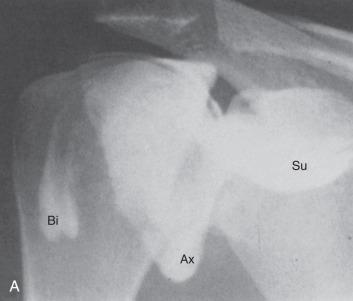
The primary factors contributing to the shift from conventional arthrography and CTA to MRI/MRA are the superb soft tissue contrast, multiplanar capabilities provided by MRI, and lack of exposure to ionizing radiation. MRI allows a global assessment of the painful shoulder, including the rotator cuff, labrum and capsular structures, osseous outlet, acromion, and articular surfaces. Bone marrow and muscle quality are readily evaluated with MRI without exposure to ionizing radiation. However, CTA is an effective alternative for patients who have contraindications to MRI.
Although many variations in technique exist, a method for performing arthrography prior to MRI or CT begins with a review of prior radiographs and/or scout films to ensure identification of pertinent abnormalities. The patient is then placed supine on the fluoroscopic table with the arm positioned next to the body in slight external rotation and a point is chosen with fluoroscopic guidance overlying the lower third of the humeral head about 0.5 cm lateral to the medial cortex of the humeral head. An alternative anterior approach is through the rotator interval or a posterior approach. Knowledge of all three approaches allows for tailored techniques based on the clinical situation; for example, a posterior approach may permit more consistent visualization of the anterior capsular structures. The skin is prepared and draped in sterile fashion and the subcutaneous tissues are anesthetized with 1% lidocaine (Xylocaine) using a 25-gauge needle, which can be advanced into the joint. Rarely, a 22-gauge, 3.5-inch spinal needle is required in order to access the joint. A small amount of radiopaque contrast material is initially injected, which will outline the medial surface of the humeral head and spill into the subscapularis recess and axillary pouch (see Fig. 38.2B ). A total injection volume of 12 to 14 mL provides adequate distention of the shoulder joint without undue discomfort. Most practices use an iodinated contrast agent for CTA and a dilute gadolinium solution for MRA. The contrast agent can be mixed with 0.1 to 0.3 mL of 1 : 1000 epinephrine to prolong retention of the contrast agent within the joint, thus allowing adequate time for transportation of the patient to the CT or MRI scanner and for imaging, which should be performed as soon as possible.
CT imaging of the shoulder is performed primarily as a means of evaluating the osseous structures after trauma. Multidetector CT utilizing isotropic data sets and post-processing techniques can accurately detect the extent of displacement and angulation of fracture fragments involving the humeral head and neck. The scapula is a complex anatomic structure composed of the body, coracoid and acromion processes, and the glenoid with its articular surface. Following a glenohumeral translational event, CT and three-dimensional volume rendered imaging are useful for presurgical planning in order to accurately depict the extent of glenoid bone loss of an osseous Bankart and the magnitude of a Hill–Sachs defect ( Fig. 38.3 ).
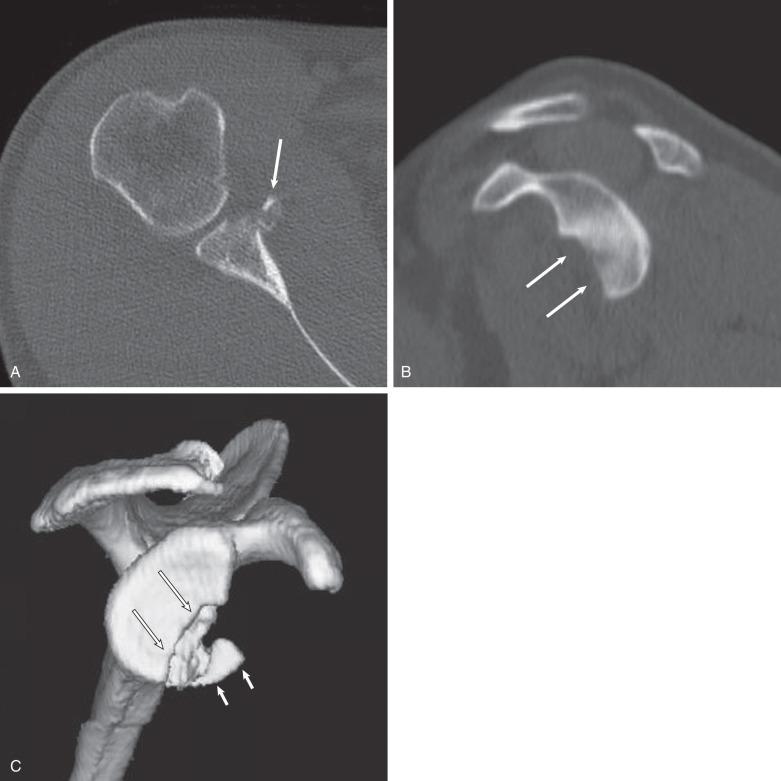
Sonography of the shoulder ( Fig. 38.4 ) is a noninvasive, accurate and cost-effective method for a dynamic evaluation of the rotator cuff and is a superb means for guided injections about the shoulder. Ultrasound examination of the shoulder requires a high-resolution linear transducer (6 to 15 MHz) and is performed with the patient in the sitting position. The tendons of the rotator cuff and the long head of the biceps should be evaluated in both the long and short axes.
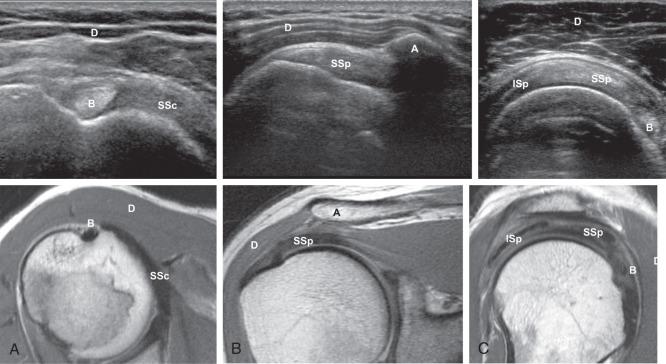
The examination begins with the arm positioned by the side and externally rotated for evaluation of the biceps long head tendon. In this position, the subscapularis can be evaluated with the elbow flexed 90 degrees and externally rotated. The infraspinatus is imaged with the arm adducted and the hand on the opposite shoulder. For evaluation of the supraspinatus, the shoulder is rotated internally, and the arm is placed behind the back, which allows the critical portion of the supraspinatus tendon to glide from beneath the acromion, allowing maximal visualization of this portion of the rotator cuff. The normal rotator cuff is sharp and uniform in its fibrillar echotexture. It measures 4 to 6 mm in thickness anteriorly, and is normally somewhat thinner posteriorly. A thin echogenic band paralleling the upper surface of the cuff reflects the subacromial–subdeltoid bursa. The overlying deltoid is characterized by the typical striated/marbled echogenicity of muscle that is distinct from the normal overlying tendons ( Table 38.1 ).
| Type of Disease | Imaging Signs |
|---|---|
| Tendinosis | Heterogeneous echogenicity of the tendon with loss of fibrillar architecture; may be thickened or thinned |
| Partial-thickness tear | Difficult, but may see focal thinning of tendon |
| Full-thickness tear | Focal full-thickness discontinuity/absence of the cuff |
| Subacromial subdeltoid bursitis | Band of anechoic/hypoechoic fluid superficial to cuff ± power Doppler hyperemia |
Although sonography of the rotator cuff has been shown to be as accurate as MRI in the evaluation of the rotator cuff tendons, sonographic evaluation of the shoulder has a steep learning curve and is operator dependent. MRI has, in its favor, a more global evaluation of the shoulder, including the labrum and osseous structures, which has led to the use of MRI in most practices.
MRI provides comprehensive evaluation of the shoulder, combining superior soft tissue depiction with the ability to simultaneously evaluate osseous pathology. MRI of the shoulder is best performed at 1.5 or 3.0 Tesla (T) utilizing a dedicated surface coil, and images are typically obtained in the axial, oblique coronal, and oblique sagittal planes relative to the anatomic axis of the shoulder ( Fig. 38.5 ). Specific protocols vary by institution, but optimally should include a combination of pulse sequences allowing for both sensitive detection of mobile water and high-resolution evaluation of anatomy. At the authors’ institution, routine shoulder imaging sequences consist of a single oblique coronal fat suppressed image (inversion recovery [IR] or T2 with fat saturation), followed by oblique coronal, axial, and oblique sagittal moderate echo time fast spin echo (FSE) images in the axial, oblique coronal, and oblique sagittal planes ( Table 38.2 ).
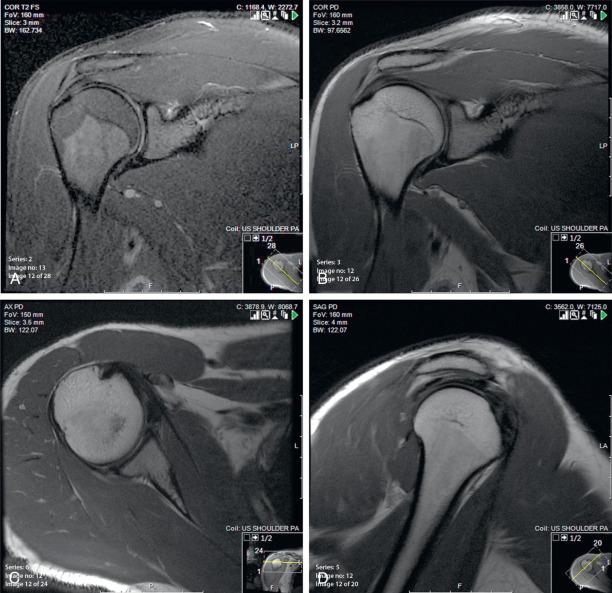
| Parameter | Coronal Fast IR | Oblique Coronal FSE | Oblique Sagittal FSE | Axial FSE |
|---|---|---|---|---|
| TR (ms) | 5000 | 4000 | 4000 | 4000 |
| TE (ms) | 17 | 34 | 34 | 34 |
| TI (ms) | 150 | na | na | na |
| BW (kHz) | 31.25 | 31.25 | 31.25 | 31.25 |
| ETL | 7 | 10 | 10 | 9 |
| NEX | 2 | 2 | 2 | 2 |
| FOV (cm) | 16 | 16 | 16 | 15 |
| Matrix | 256 × 192 | 512 × 3S4 | 512 × 224 | 512 × 384 |
| Slice/gap (mm) | 3/D | 3/0 | 4/0.5 | 3.5/0 |
| NPW | Yes | Yes | Yes | Yes |
| Frequency | R/L | R/L | A/P | R/L |
Specialized MRI techniques may be useful for certain applications. For reduction of motion artifact in patients who are unable to remain still during pulse acquisition, the periodically rotated overlapping parallel lines with enhanced reconstruction (PROPELLER) pulse sequence, utilizing radial sampling of parallel data lines rotating about the center of K space, reduces the severity of motion artifact, thereby improving image quality and diagnostic yield.
MRI of the postoperative shoulder requires knowledge of the surgical intervention performed, in order to allow the implementation of proper pulse parameter modifications if necessary, such as in the presence of extensive metallic hardware. When utilizing conventional pulse sequences in the presence of metal, techniques that may be used to decrease artifact include widening the receiver bandwidth, aligning the frequency encoding axis along the long axis of the implant, and oversampling in the frequency direction. Additional improvement in image quality may be obtained by decreasing the voxel size and increasing the number of excitations. Because the artifact generated by a particular metal implant increases with field strength, imaging at higher field strengths, such as 3.0T, should be avoided. Additionally, frequency selective fat suppression methods should be avoided in favor of methods that are less frequency dependent (e.g., short tau inversion recovery [STIR]) and therefore more robust in the presence of field inhomogeneities that occur in the vicinity of metal hardware.
In the setting of large metallic implants, specialized pulse sequences designed to significantly reduce metal artifact may be employed. These include multiple acquisition variable resonance image combination (MAVRIC) and slice encoding metal artifact correction (SEMAC). MAVRIC utilizes multiple acquisitions at varying off-resonance spectral frequency bins, which are subsequently postprocessed to create images with significantly reduced susceptibility artifact. SEMAC utilizes view angle tilting plus the addition of a phase encoding step in the Z axis, resulting in extremely robust spatial encoding which diminishes the amount of artifact.
Evaluation of early chondral degeneration may be performed using quantitative parametric MRI techniques, which have been demonstrated to correlate to early changes in chondral matrix elements, including proteoglycan and collagen, prior to the development of gross morphologic changes visible on routine conventional imaging sequences. These techniques include T2 mapping, which is sensitive to changes in collagen orientation and free water content, and spin lattice relaxation in the rotating frame (T1 rho), which is sensitive to depletion of proteoglycan. Delayed gadolinium enhanced MRI of cartilage (dGEMRIC) is an additional biomarker for proteoglycan depletion, though requires the intravenous administration of gadolinium-based contrast material.
While CT remains the gold standard for high resolution evaluation of mineralized bone, newer “silent” magnetic resonance (MR) techniques, such as zero TE imaging, allow evaluation of bone with CT-like contrast concurrently with the acquisition of routine clinical MR sequences, obviating the need for a separate imaging study and a dose of ionizing radiation, though these sequences are not yet in widespread clinical use.
MRA: While some authors have described an advantage in detecting chondral and labral pathology following the intra-articular administration of gadolinium contrast material, others have achieved statistically equivalent or superior sensitivity and specificity utilizing optimized high resolution noncontrast techniques. The accuracy of MRA versus noncontrast MRI depends largely upon the experience and preference of the interpreting radiologist, and therefore the viewpoint of which technique is optimal in a given situation will often depend on the convention of a particular institution. At the authors’ institution, high resolution noncontrast imaging is preferred, given its ability to reliably detect chondral and labral lesions while simultaneously allowing direct visualization of the synovium and evaluation of chondral signal changes in the setting of early degeneration without a frank chondral defect.
Interpretation of a shoulder MRI examination requires the evaluation of images obtained in several imaging planes and with various pulse sequences. The following sections provide a systematic approach for MRI evaluation as the imaging basis for recognizing common pathologic processes; when appropriate, complementary imaging modalities are discussed. The important structures that must be thoroughly evaluated on each MRI examination include the osseous structures (outlet and acromion), the rotator cuff muscles and tendons, the biceps tendon and rotator interval, and the labrum (capsular structures and articular surfaces).
The clinical syndrome of shoulder impingement refers to a painful compression of the soft tissues of the anterior shoulder (i.e., the rotator cuff, subacromial bursa, and bicipital tendon) between the humeral head and the coracoacromial arch (i.e., the coracoid process, acromion, coracoacromial ligament and AC joint). Pain occurs when the arm is elevated forward and internally rotated or placed in the position of abduction and external rotation.
In the normal shoulder, the upward pull of the deltoid on the proximal humerus is resisted by an intact rotator cuff so that the humeral head remains centered on the glenoid in all ranges of motion. If this stabilizing mechanism becomes weakened as a result of trauma, overuse or age, the humeral head is pulled upward under the structures of the coracoacromial arch. Impingement is initially followed by subacromial bursitis and rotator cuff tendinopathy. Over time, irreversible cuff trauma occurs with fibrosis and degeneration. In the latter stages, subacromial enthesophyte tends to form at the anteroinferior margin of the acromion where the coracoacromial ligament attaches ( Fig. 38.6 ). Tears of the rotator cuff are frequent in this stage, undoubtedly in part because of direct cuff trauma from the spur. After massive tears of the rotator cuff, the humeral head typically migrates anterosuperiorly and chronic impaction with the undersurface of the anterior acromion results in sclerosis and proliferative changes—acetabularization.
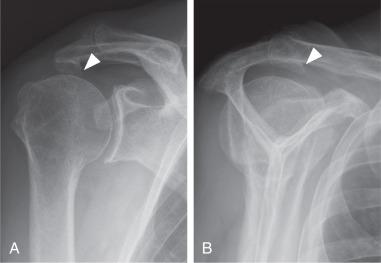
Neer (1983) introduced the term impingement syndrome and described three stages with the rotator cuff disorder. The diagnosis of impingement syndrome is usually made clinically on the basis of appropriate historical and physical examination findings. A thorough history and physical examination by an experienced physician have an 84% to 90% sensitivity and a 75% to 95% specificity for diagnosis of a tear of the rotator cuff. Many imaging modalities are available to assist in the evaluation of the progressively painful shoulder, and their role is both to assess the extent of abnormality of the rotator cuff and to identify configurations of the osseous outlet that may predispose to rotator cuff impingement.
The osseous changes that occur with impingement are seen late and thus offer little in establishing an early diagnosis and preventing progression of the associated soft tissue injuries. The following osseous abnormalities may be associated with the clinical syndrome of impingement :
Enthesophyte formation on the anteroinferior aspect of the acromion
A long anterior portion of the acromion with downward sloping of the acromion
An os acromiale that is not fused
AC joint arthrosis with hypertrophy
Optimal conventional radiographic views have been described for identifying these variations of the osseous outlet. The AP radiograph at a 30-degree caudal angle is helpful in visualizing the anterior aspect of the acromion and in detecting inferiorly directed enthesophytes. A modified transcapular lateral view obtained with 10 to 15 degrees of caudal angulation (the supraspinatus outlet view) helps further identify the anteroinferior aspect of the acromion (see Fig. 38.6 ). A high-riding humeral head with remodeling of the undersurface of the acromion and sclerosis of the greater tuberosity are conventional radiographic findings ( Fig. 38.7 ) that are pathognomonic of a chronic rotator cuff insufficiency.
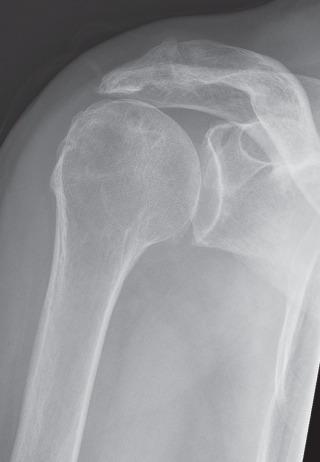
The multiplanar capabilities of MRI and its ability to demonstrate the relationship of the entire osseous outlet to the underlying rotator cuff allow excellent assessment of the outlet. Bigliani described three different radiographic acromial shapes ( Fig. 38.8 ) and related the configuration of the undersurface of the acromion to the presence of rotator cuff tears. A type I acromion (see Fig. 38.8A ) has a flat undersurface, a type II acromion (see Fig. 38.8B ) has a curved undersurface, and a type III acromion (see Fig. 38.8C ) has an anterior hook. The acromial types II and III have an increased association with rotator cuff tears. A type IV acromion with a convex undersurface has been described, but no definite correlation has been shown to exist between type IV acromion and impingement (see Fig. 38.8D ). On MRI, the shape of the acromion is best assessed on the oblique sagittal view just lateral to the AC joint. However, one study suggests poor correlation of acromial arch shape between conventional radiography and MRI. Another study found no association between rotator cuff tears and the acromial structure. A third study reported poor interobserver agreement between radiographs and MRI scans at the categorization of the acromial shape.
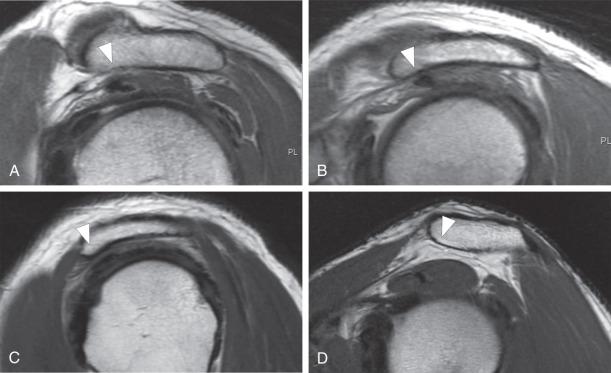
Downward sloping of the acromion can also narrow the supraspinatus outlet and potentially result in impingement, and is best seen on the oblique coronal images ( Fig. 38.9 ). An enthesophyte ( Fig. 38.10 ) extending off the anteroinferior aspect of the acromion also can be clearly demonstrated on MRI. It typically appears as a marrow-containing osseous excrescence. Potential pitfalls include the attachment of the coracoacromial ligament and the anterolateral acromial attachment of the deltoid (see Fig. 38.10 ). These structures may mimic an osseous excrescence, but they can be differentiated from enthesophytes by correlating with concurrent radiographs and because they lack marrow signal and appear dark on all pulse sequences. The acromion should also be evaluated for an os acromiale, which is an accessory ossification center along the outer edge of the anterior acromion. It is normally fused by 25 years of age. An association exists between persistent os acromiale and impingement of the rotator cuff. The deltoid muscle attaches to the inferior aspect of the accessory ossicle, and contraction of the deltoid results in a downward motion of the unstable segment, potentially leading to impingement of the underlying rotator cuff ( Fig. 38.11 ). Os acromiale are demonstrated best on axial MR images. MRI signs of instability of the os acromiale include fluid signal within the synchondrosis as well as sclerosis, cystic change, and marrow edema on either side of the synchondrosis ( Box 38.2 ).
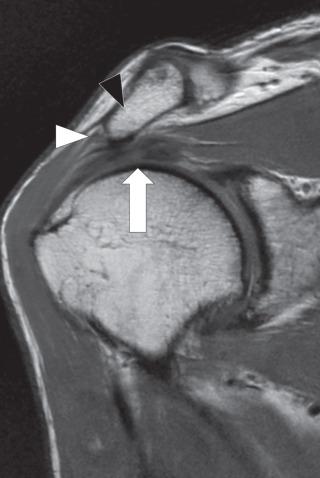
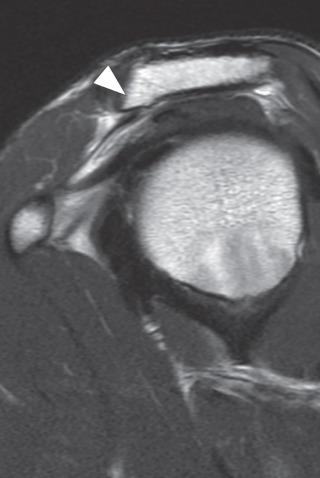
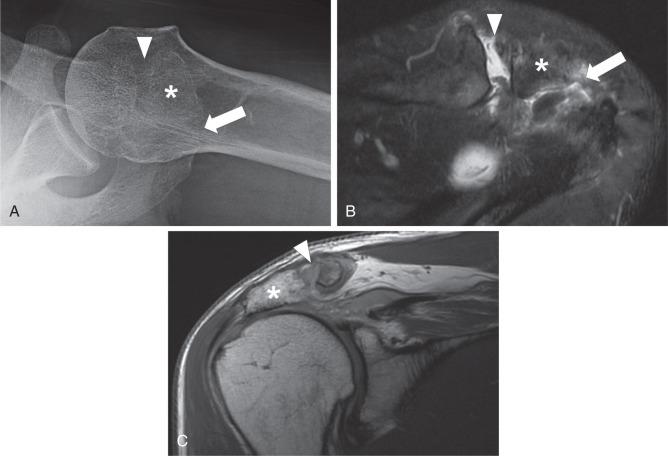
Acromion type—assessed on the oblique sagittal sequences on the image immediately lateral to the acromioclavicular joint:
Type I: Flat undersurface
Type II: Curved undersurface
Type III: Anterior hook
Type IV: Convex undersurface
Downward sloping—assessed on sagittal and coronal oblique sequences
Acromial spur—assessed on sagittal and coronal oblique fast spin echo sequences (fatty marrow signal within the bony excrescence differentiates a spur from the deltoid tendon slip or coracoacromial ligament)
Unfused os acromiale—best assessed on axial images (fluid signal within the synchondrosis suggests instability)
Hypertrophic changes of the AC joint capsule and inferiorly directed osteophyte formation ( Fig. 38.12 ) can also be associated with impingement. MRI is useful to evaluate for mass effect on the underlying rotator cuff. The coracoacromial ligament ( Fig. 38.13 ), a soft tissue structure that forms part of the coracoacromial arch extends from the coracoid to the acromion and is well seen on oblique sagittal MR images. It normally measures less than 2 mm in thickness and extends across the rotator interval and anterior aspect of the supraspinatus tendon. The role of the coracoacromial ligament in impingement remains controversial; some believe that thickening or ossification of the ligament may be a potential cause of impingement, whereas others believe that thickening results from impingement.
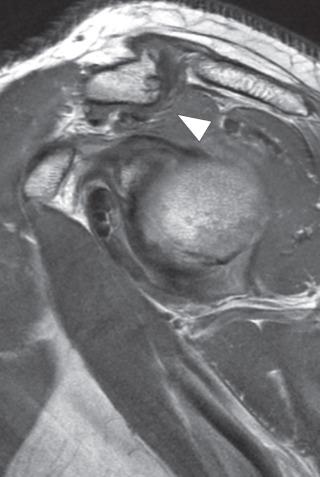
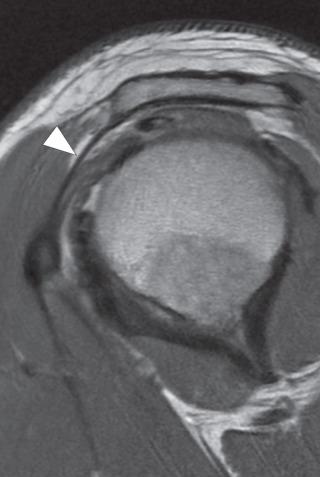
Coracohumeral impingement, also referred to as subcoracoid or coracoid impingement, is an uncommon cause of extrinsic impingement that results from a narrowed distance between the coracoid process and the underlying humeral head ( Fig. 38.14 ). Lo and Burkhart suggested using an interval less than 6 mm to make the diagnosis at arthroscopy. On axial images, the normal interval is approximately 10 mm. A narrowed coracohumeral distance may result in entrapment of the subscapularis tendon between the coracoid process and the humeral head, and can lead to isolated tendinosis and disruption of the subscapularis tendon. Abnormalities isolated to the subscapularis tendon should prompt an investigation of the coracohumeral distance and consideration of this diagnosis. However, after reporting on a small series of patients with subcoracoid impingement at arthroscopy and control subjects, Giaroli et al. concluded that subcoracoid impingement is primarily a clinical diagnosis that may be supported with imaging.
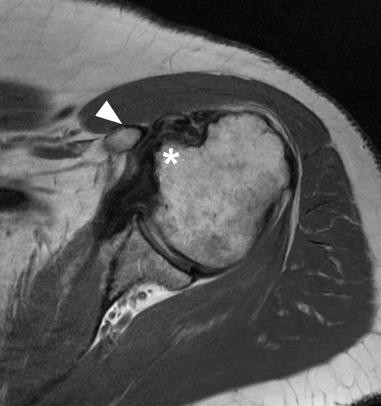
The rotator cuff is composed of four tendons: the supraspinatus superiorly, the subscapularis anteriorly, and the infraspinatus and teres minor posteriorly. These tendons are important dynamic stabilizers of the glenohumeral joint. Most cuff failures originate in the supraspinatus tendon at or near its insertion onto the greater tuberosity of the humeral head. The supraspinatus tendon receives its arterial supply from the anterior humeral circumflex, subscapular, suprascapular, and posterior humeral circumflex arteries. A zone of relative avascularity has been described in the tendon proximal to its attachment site and may represent a “critical zone” for cuff failure. Other authors have found this zone to be vascularized by anastomosing vessels from the tendon and humeral tuberosity. Arterial filling of the cuff vessels in the critical zone depends on the position of the arm; poor filling is present when the arm is adducted. A high correlation also has been shown to exist between rotator cuff tears and subacromial impingement. It is probably a combination of avascularity and subacromial impingement that leads to most rotator cuff abnormalities originating in the critical zone of the supraspinatus tendon.
Conventional radiography only plays a limited role in the direct evaluation of the rotator cuff, although it is frequently the initial imaging study performed for patients with the clinical syndrome of impingement. Radiographs allow identification of associated pathologic change, especially of the osseous outlet and acromion. Conventional radiography findings associated with cuff pathology include the following :
Enthesopathic changes at the cuff footprint on the humeral head
Calcific tendinopathy/bursitis
A high-riding humeral head with an acromiohumeral interval less than 7 mm is associated with rotator cuff insufficiency
Remodeling of the acromial undersurface to frank acetabularization
Become a Clinical Tree membership for Full access and enjoy Unlimited articles
If you are a member. Log in here